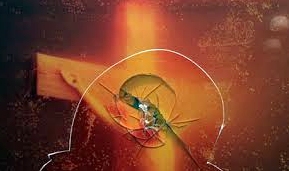commentary
 f we didn't know anything about it, we'd think Piss Christ was a
beautiful religious picture. If it had been called The Glory of
Jesus we might wonder about the red color, but it would be a religious icon
by now and we would all admire it (though we might have been even more
‘pissed’ when we later discovered how it was made.)
f we didn't know anything about it, we'd think Piss Christ was a
beautiful religious picture. If it had been called The Glory of
Jesus we might wonder about the red color, but it would be a religious icon
by now and we would all admire it (though we might have been even more
‘pissed’ when we later discovered how it was made.)
Piss Christ is a photograph of a plastic crucifix partially submerged in a red liquid that the photographer, Andres Serrano, claimed was urine. (I'm not a urologist, but if that's really true, then the artist is well advised to get a checkup. If you ask me, it's a clear case of hematuria.)
I suspect the title, in Serrano's mind, was not so much a dig at Christianity as an ‘anti-title’ in the tradition of Rothko's No. 10 or Jackson Pollock's Silver Over Black, White, Yellow, and Red—meant to describe the technique rather than the subject, and thereby liberate the viewers to interpret the work in their own way. Which, I guess, they're doing.

Immersion (Piss Christ) as modified by performance artists in 2011
What I'm getting at is that the title goes a long way to explaining why we so often feel that our culture is in a tailspin. Many people feel uncomfortable about culture unless they're being cynical. Serrano couldn't come out and say he's trying to inspire religious feelings—he had to knock them down. To create something worthy of admiration just seems corny.
Serrano claims to be a Christian himself. He pointed out that crucifixion is an ugly and messy way of killing a person. “When you see it,” The Guardian newspaper quotes him as saying, “you're not horrified by it at all, but what it represents is the crucifixion of a man ... if Piss Christ upsets you, maybe it's a good thing to think about what happened on the cross.”
The photograph was damaged in France by Christian fundamentalist protesters in 2011. Yes, it's only a photograph, and it's understandable why Christians were upset, but the urge to destroy sacreligious artifacts is a common one. For example, the Taliban destroyed the Bamiyan Buddha statues in Afghanistan for the same reason in 2001.
That puts Serrano in the same league as Charlie Hebdo and the other anti-Muslim artists in Europe (with one big difference: Serrano doesn't have to go into hiding). The images of Muhammad in Pamela Geller's art show in Texas may not be of comparable artistic quality, but the freedom to participate in religion or denigrate it as we see fit is what makes our civilization worthy of emulation.
The real problem with Piss Christ is that the government, which is supposed to remain neutral on religion and culture, paid for it. It shows. When religious groups create art, we get the Bamiyan statues or the Cathedral of Notre Dame (which, ironically, was desecrated during the French Revolution). When governments create art, we get stuff like socialist realism and Piss Christ: maybe visually interesting, but fundamentally soulless. The cynicism in this picture probably pissed off the Christians as much as the sense of disrespect.
Where Piss Christ succeeds is as a depiction of how modern culture denigrates tradition. But regardless of its intent, the government should not be paying for it. The role of government is to enforce property laws and make sure people don't shoot each other. Subsidizing culture puts their weight on one side of the culture wars. Get 'em out of it.
